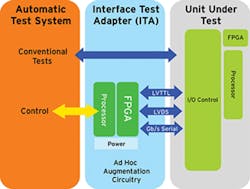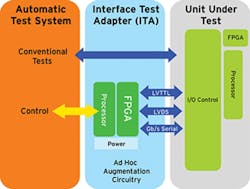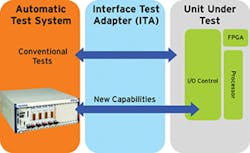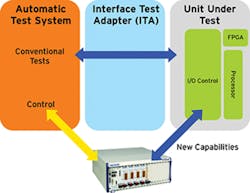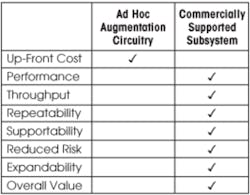Addressing New Requirements for Legacy Test Stations
Large-scale ATE like that used for maintaining defense and aerospace electronics has a typical lifetime of 20 years or more and can support multiple and equally large-scale platforms that may have an even longer lifespan. It is customary to upgrade the platform electronics periodically to improve functionality and reliability, which may create requirements that exceed the capabilities of the ATE. An example is testing high-speed digital buses that use technology developed over the past decade.
This article details an approach for augmenting test system capabilities to address new requirements. While most examples are drawn from the defense and aerospace industries, the principals could apply to any industry in which electronics are expected to have very long useful lives.
Why Does ATE Have to Last So Long?
Much of the ATE currently in the field in the defense and aerospace industries was provisioned to test platforms designed when the dominant digital technology was single-ended TTL, early generations of CMOS logic, and discrete, often high-voltage circuitry—literally technology from the last century. Logic devices were powered by supply voltages of 5 V or more and interfaced with discrete control circuitry driven by a variety of supply voltages, ranging as high as 30 V or more. The capability to interface accurately with a wide range of voltages and currents is important when ATE is applied to these designs. Data rates below 50 MHz typically are adequate vs. the 50 to 2,000 MHz common in today’s designs.
The digital instrumentation that interfaces with this logic has very different capabilities than what is required for the new breed of high-speed bus, and this is a common driver today for upgrading or replacing ATE. The newer buses start at speeds where TTL left off. Technologies such as low-voltage TTL (LVTTL) first pushed speeds to the vicinity of 100 MHz but brought challenges in terms of the inability to drive the typically long cables that connect the test equipment to the UUT.
Next, the move toward differential logic facilitated still higher data rates. To simplify the interconnections between circuit assemblies, wide parallel buses were replaced with narrower and faster buses and finally by very high-speed, narrow serial buses with speeds approaching 1 Gbit/s or more.
Increasingly, buses employ differential signaling with ever-decreasing voltage swings. Most new designs focus on the low-voltage differential signaling (LVDS) standard that uses current-mode logic resulting in typical voltage swings of 350 mV. As platform upgrades introduce new buses, the existing test systems need a new class of instrumentation to address them, and the owners, often the government, need to choose between replacing or upgrading the ATE.
While at first blush it may seem easier just to replace legacy ATE with new systems, this is a long and expensive process. The replacement test equipment must support the original features of, for instance, an F-18 aircraft in addition to the requirements for the new avionics upgrades. It can take well more than a decade to plan and deploy such a new test system.
Another approach would be to maintain two separate systems—one to test the original features of the aircraft and one to test the new. This approach not only would be expensive, but it also is counter to the universal desire to consolidate test into a single test-station design. In addition, even the new platform upgrades generally contain legacy interface circuitry that requires the testers to be equipped simultaneously with both old and new capabilities. For these reasons, most organizations opt to augment their legacy ATE with new capabilities.
The Homegrown Approach to System Augmentation
Over the past decades, new designs with high-speed digital buses have made their way through the logistics pipeline and must be addressed on ATE to service weapons-system electronics. Since the legacy test equipment lacks the native capability to address the bus requirements, the problem is left in the hands of the test program set (TPS) developer.
A common augmentation strategy is for a test department to build applications-specific circuitry into the interface test adapter (ITA) located between the test system and the UUT (Figure 1). This ad hoc augmentation circuitry strategy also can be thought of as a “duct-tape approach” because it typically is viewed as a good short-term solution but a poor long-term one for three primary reasons:
Performance
The performance of the solution often is lacking because typically there is insufficient time or resources available to perform a commercial-grade implementation. It is difficult to address all of the technical bus requirements, and overall system throughput often is lacking. The result is marginal adherence to the test requirements and excessive test times.
Usability
The ad hoc augmentation circuitry approach rarely results in easy-to-use equipment. Unlike commercial equipment, there generally are no training classes, detailed documentation, programming examples, or outside experts to help the TPS development effort.
Supportability
Complex circuitry in the ITA is expensive to support over time. Replication of complex ITAs also is expensive and made more so by the usual lack of detailed design data. Over a lifetime of one or two decades, components will become obsolete, and this places a huge burden on future test departments.
A Structured Subsystem Approach to ATE Augmentation
An alternative approach that has emerged in recent years integrates a commercial, self-contained subsystem designed and supported for integration into large-scale ATE. The subsystem is a self-contained solution for a specific class of requirements, such as high-speed digital buses. A local computer allows the subsystem to perform in a predictable manner, independent of the main ATE computer that is likely already at capacity or at the end of its own lifecycle. The subsystem can be populated with the appropriate number of intelligent, reprogrammable instruments selected to satisfy a wide range of new UUTs.
Rather than the UUT-specific custom nature of ad hoc augmentation circuitry, this new approach leverages resources across multiple different test units, further mitigating the programming and support problems. A self-contained subsystem can perform the bus operations as a stand-alone unit in a laboratory, which allows test development to be performed in a more cost-effective manner than doing so on the ATE.
The self-contained subsystem can be integrated into the ATE and the test development environment as easily as adding a new instrument. Better yet, the test code that controls the subsystem behavior can be developed and run within the subsystem itself and simply invoked from the environment of the legacy tester. This arrangement minimizes the alterations needed to accommodate the new functionality.
A subsystem can be either mechanically integrated within the mainframe of the legacy test system or act as an external, but software-integrated, ancillary unit (Figure 2). External operation may be a practical solution if there is inadequate rack space in the system or if it is organizationally difficult to make permanent internal configuration changes.
Economic Benefits of the Subsystem
The deficiencies of the ad hoc augmentation circuitry approach have been identified in terms of performance, usability, and supportability. These characteristics also can be used to understand the advantages of the self-contained subsystem:
Performance
A subsystem is populated with commercial instruments: each addresses a specific bus or is reconfigurable for multiple buses. In either case, bus experts perform the development effort, ensuring the best possible conformance to each bus specification. The individual instruments are integrated into the subsystem, which provides a high-speed software and hardware infrastructure that delivers high throughput in production.
Usability
A commercially designed and supported subsystem provides features and support that optimize usability for the test developer. This includes documentation, training classes, detailed use cases and examples, and the availability of direct applications engineering support.
Supportability
In markets such as defense and aerospace, many test vendors are experienced in supporting equipment over the long life of large-scale systems. A subsystem vendor is able to integrate instruments that are available for many years and supportable for many more. These suppliers are well versed in the management of component obsolescence, which, if not done properly, can force expensive changes to test programs.
Careful design of the subsystem hardware and infrastructure software permits periodic upgrades without major disruption of the test program. The utilization of the subsystem components is optimized by the fact that they are used by many UUTs, which minimizes the overall hardware investment and related support costs.
Subsystems also can provide significant long-term cost advantages. In contrast to custom, low-volume designs, a subsystem can be developed for use with many types and brands of ATE systems (Figure 3), bringing economies of scale.
In addition, because subsystems are able to interface and integrate with the much older computer hardware and software that execute the test program on the legacy system, they enable organizations to extend the useful life of and investment in their original ATE by decades. And, when the legacy system finally is retired, the subsystem can continue to provide proven functionality in the next-generation system.
While the up-front cost of a subsystem typically is higher than ad hoc augmentation circuitry, consider the value of the UUT it is protecting (Table 1). With cuts in defense spending and an overall weak economy, both military and civilian organizations are striving to make their capital assets or platforms last even longer, which likely means intermittent updates rather than wholesale replacement. The ATE for these assets must follow along. Subsystems offer technical and economic advantages in this environment.
About the Author
Peter Hansen is the product marketing manager for instrumentation for the MIL/Aero business unit of the Assembly Test Division at Teradyne. The 40-year veteran of the ATE industry has been employed by Teradyne since 1977 in marketing and engineering management positions. Hansen graduated from Rensselaer Polytechnic Institute in 1969. [email protected]
